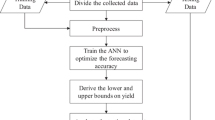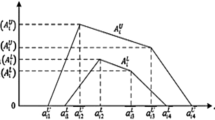Abstract
An interval fuzzy number-based approach was proposed in this study to model an uncertain yield learning process. The study aimed to overcome the limitations of present methods, wherein the lower and upper bounds of the yield are generally determined by few extreme cases, thus resulting in an unacceptable widening of the yield range. In the proposed interval fuzzy number-based approach, the range of yield was divided into two sections, namely inner and outer sections, which corresponded with the lower and upper membership functions of a fuzzy yield forecast based on interval fuzzy numbers, respectively. To fulfill different managerial objectives, in this approach, all actual values are included in the outer section, whereas most of these values fall within the inner section. To derive the values of parameters in a fuzzy yield learning model based on interval fuzzy numbers, a mixed binary nonlinear programming model was proposed and optimized. The interval fuzzy number-based approach was applied to two real-time cases for evaluating its effectiveness. According to experimental results, the performance of the proposed method was superior to that of several existing methods, particularly in terms of forecasting precision for the average range. Forecasting accuracy obtained using the interval fuzzy number-based approach was satisfactory.











Similar content being viewed by others
Explore related subjects
Discover the latest articles and news from researchers in related subjects, suggested using machine learning.References
Ashtiani B, Haghighirad F, Makui A, ali Montazer G (2009) Extension of fuzzy TOPSIS method based on interval-valued fuzzy sets. Appl Soft Comput 9(2):457–461
Atanassov K, Gargov G (1989) Interval valued intuitionistic fuzzy sets. Fuzzy Sets Syst 31(3):343–349
Baležentis T, Zeng S (2013) Group multi-criteria decision making based upon interval-valued fuzzy numbers: an extension of the MULTIMOORA method. Expert Syst Appl 40(2):543–550
Baron M, Takken A, Yashchin E, Lanzerotti M (2008) Modeling and forecasting of defect-limited yield in semiconductor manufacturing. IEEE Trans Semicond Manuf 21(4):614–624
Blancett RS (2002) Learning from productivity learning curves. Res Technol Manag 45(3):54–58
Cabrerizo FJ, Pérez IJ, Herrera-Viedma E (2010) Managing the consensus in group decision making in an unbalanced fuzzy linguistic context with incomplete information. Knowl Based Syst 23(2):169–181
Chen T (2012) Ahybrid fuzzy and neural approach with virtual experts and partial consensus for DRAM price forecasting. Int J Innov Comput Inf Control 8(1B):583–598
Chen T (2017) A heterogeneous fuzzy collaborative intelligence approach for forecasting the product yield. Appl Soft Comput 57:210–224
Chen T (2018) An innovative fuzzy and artificial neural network approach for forecasting yield under an uncertain learning environment. J Ambient Intell Humaniz Comput 9:1013–1025
Chen T, Lin YC (2008) A fuzzy-neural system incorporating unequally important expert opinions for semiconductor yield forecasting. Int J Uncertain Fuzziness Knowl Based Syst 16(1):35–58
Chen TCT, Lin CW (2018) An innovative yield learning model considering multiple learning sources and learning source interactions. Comput Ind Eng (in press)
Chen T, Wang MJ (1999) A fuzzy set approach for yield learning modeling in wafer manufacturing. IEEE Trans Semicond Manuf 12(2):252–258
Chen T, Wang YC (2014) An agent-based fuzzy collaborative intelligence approach for precise and accurate semiconductor yield forecasting. IEEE Trans Fuzzy Syst 22(1):201–211
Dahooie JH, Zavadskas EK, Abolhasani M, Vanaki A, Turskis Z (2018) A novel approach for evaluation of projects using an interval-valued fuzzy additive ratio assessment (ARAS) method: a case study of oil and gas well drilling projects. Symmetry 10(2):45
Dimuro GP (2011) On interval fuzzy numbers. In: IEEE workshop-school on theoretical computer science, pp 3–8
Dong Y, Zhang H, Herrera-Viedma E (2016) Integrating experts’ weights generated dynamically into the consensus reaching process and its applications in managing non-cooperative behaviors. Decis Support Syst 84:1–15
Donoso S, Marin N, Vila MA (2006) Quadratic programming models for fuzzy regression. In: Proceedings of international conference on mathematical and statistical modeling in honor of Enrique Castillo
Dunham W (1990) Journey through genius: the great theorems of mathematics. Wiley, New York
Gruber H (1994) Learning and strategic product innovation: theory and evidence for the semiconductor industry. Elsevier Science B. V, The Netherlands
Guijun W, Xiaoping L (1998) The applications of interval-valued fuzzy numbers and interval-distribution numbers. Fuzzy Sets Syst 98(3):331–335
Herrera-Viedma E, Cabrerizo FJ, Kacprzyk J, Pedrycz W (2014) A review of soft consensus models in a fuzzy environment. Inf Fusion 17:4–13
Huang D, Chen T, Wang MJJ (2001) A fuzzy set approach for event tree analysis. Fuzzy Sets Syst 118(1):153–165
Jaeger H, Haas H (2004) Harnessing nonlinearity: predicting chaotic systems and saving energy in wireless communication. Science 304(5667):78–80
Keršuliene V, Zavadskas EK, Turskis Z (2010) Selection of rational dispute resolution method by applying new step-wise weight assessment ratio analysis (SWARA). J Bus Econ Manag 11(2):243–258
Krueger DC, Montgomery DC, Mastrangelo CM (2011) Application of generalized linear models to predict semiconductor yield using defect metrology data. IEEE Trans Semicond Manuf 24(1):44–58
Kulkarni SS (2006) The impact of uncertain yield on capacity acquisition in process plant networks. Math Comput Model 43(7–8):704–717
Lee CS, Chung CC, Lee HS, Gan GY, Chou MT (2016) An interval-valued fuzzy number approach for supplier selection. J Mar Sci Technol 24(3):384–389
Liu P, Jin F (2012) A multi-attribute group decision-making method based on weighted geometric aggregation operators of interval-valued trapezoidal fuzzy numbers. Appl Math Model 36(6):2498–2509
Moore RE (1979) Methods and applications of interval analysis. SIAM, Philadelphia
Peters G (1994) Fuzzy linear regression with fuzzy intervals. Fuzzy Sets Syst 63:45–55
Rashid T, Beg I, Husnine SM (2014) Robot selection by using generalized interval-valued fuzzy numbers with TOPSIS. Appl Soft Comput 21:462–468
Shu MH, Wu HC (2010) Measuring the manufacturing process yield based on fuzzy data. Int J Prod Res 48(6):1627–1638
Tanaka H, Watada J (1988) Possibilistic linear systems and their application to the linear regression model. Fuzzy Sets Syst 272:275–289
Tirkel I (2013) Yield learning curve models in semiconductor manufacturing. IEEE Trans Semicond Manuf 26(4):564–571
Tirkel I, Rabinowitz G, Price D, Sutherland D (2016) Wafer fabrication yield learning and cost analysis based on in-line inspection. Int J Prod Res 54(12):3578–3590
Wang CX (2009) Random yield and uncertain demand in decentralised supply chains under the traditional and VMI arrangements. Int J Prod Res 47(7):1955–1968
Wei SH, Chen SM (2009) Fuzzy risk analysis based on interval-valued fuzzy numbers. Expert Syst Appl 36(2):2285–2299
Wei G, Zhao X, Lin R (2013) Some hesitant interval-valued fuzzy aggregation operators and their applications to multiple attribute decision making. Knowl Based Syst 46:43–53
Wu HC, Chen T (2015) CART–BPN approach for estimating cycle time in wafer fabrication. J Ambient Intell Humaniz Comput 6(1):57–67
Zhang C, Wang C, Zhang Z, Tian D (2018) A novel technique for multiple attribute group decision making in interval-valued hesitant fuzzy environments with incomplete weight information. J Ambient Intell Humaniz Comput. https://doi.org/10.1007/s12652-018-0912-2
Acknowledgements
This study was sponsored by the Ministry of Science and Technology, Taiwan.
Author information
Authors and Affiliations
Corresponding author
Additional information
Publisher’s Note
Springer Nature remains neutral with regard to jurisdictional claims in published maps and institutional affiliations.
Rights and permissions
About this article
Cite this article
Chen, T., Wang, YC. Interval fuzzy number-based approach for modeling an uncertain fuzzy yield learning process. J Ambient Intell Human Comput 11, 1213–1223 (2020). https://doi.org/10.1007/s12652-019-01302-5
Received:
Accepted:
Published:
Issue Date:
DOI: https://doi.org/10.1007/s12652-019-01302-5




